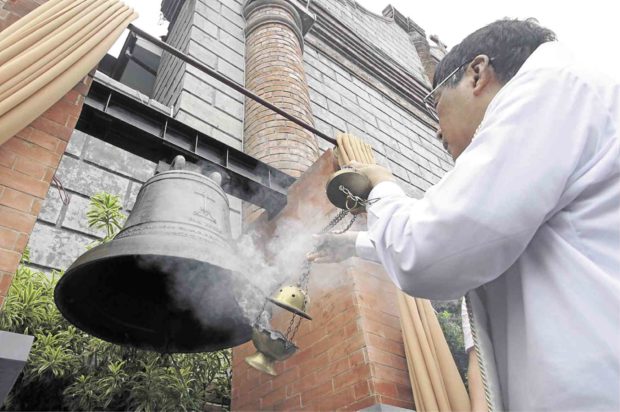
The San Pedro bell is installed in front of the Catholic church in Bauang town in La Union province, after its return from the United States last year. —RICHARD BALONGLONG
BAUANG, LA Union — President Rodrigo Duterte has demanded the return of the three Balangiga bells, but people who convinced the United States to return the war booty taken in 1901 from this town’s church said diplomacy and friendship helped them get their bell back.
The century-old San Pedro bell of Bauang has been displayed in front of the town church since the Americans returned it on May 23, 2016.
“We hope the United States will return the Balangiga bells, but we should not let hate … be our motivation in bringing them back. We hope there would be a peaceful coordination between the Philippines and the United States,” Myrna Romero, Bauang tourism officer, said.
Friendly relations
Romero said the country’s friendly relationship with the United States was key to bringing back the San Pedro bell.
“So being friendly in our request could also help persuade the United States to return the Balangiga bells,” she said.
The Balangiga bells were taken in 1901 by American soldiers from Balangiga town in Eastern Samar province as war trophies.
Days after Mr. Duterte demanded for their return, US Ambassador Sung Kim said his government was willing to surrender them, adding that “it was aware of the significant meaning of the bells to Filipinos.”
Homecoming
The 834-pound (378.3 kg) San Pedro bell, said to be made of alloy of silver and copper, was too heavy for the church’s belfry so it was given a special place instead.
“The bell can’t be rung anymore because of a chip in the lip and using it could result in further damage,” Romero said.
It was only during its installation last year when the bell pealed for residents here, 24 days after it was rung for the last time at Most Holy Trinity chapel of the US Military Academy (USMA) in West Point, New York.
The homecoming of the San Pedro bell was without complications. It involved correspondence between local and Church officials and those of USMA for several months.
“This could be because the bloody battle that resulted in American soldiers taking the Balangiga bells was well-documented in the country’s war records, while there was no record of the San Pedro bell at all, or how it landed in the US,” Romero said.
Bauang did not even know the bell existed. It was taken by American soldiers to their country in 1901 but it was until a retired US Army captain, Dennis Wright, and his group researched on its existence that local and Church officials learned about it.
Wright said he learned about the San Pedro bell while he was researching on efforts to return the Balangiga bells.
He said the Barry bell, named after US Gen. Thomas Barry, was actually the missing San Pedro bell of Bauang.
It was Barry who presented the bell to USMA at West Point in 1915 where it remained for the next century.
Origin
Over the subsequent decades, the origin of the bell and much of its history were obscured until 2015 when Wright and his group rediscovered it.
According to USMA records, the San Pedro bell came from the Philippines, although no details were available about the circumstances of its removal, its location and from what church it belonged, Wright said.
There were just clues—the symbol of the Augustinian cross, the name “San Pedro,” the year 1883, and the name of the parish priest, Mariano Garcia, to whom the bell was presented.
Wright also discovered the names of its donors, Lt. Gov. Mariano Balancio and Lt. Hilario Calica, and the name “Bauang,” which were inscribed on the bell.
Armed with the limited information, Wright and his group of American veterans tracked down the town in La Union with an Augustinian church named St. Peter.